Want to start reading at the beginning of the trip? Click here.
Fengdu to Chongqing
Oct. 22
Sometime in the night, we docked at Fengdu, the so-called “Ghost City.” In the morning, after a buffet breakfast, we went ashore. I mention breakfast because throughout our trip, a bountiful morning meal was provided—both aboard the Victoria Queen and at each hotel. The hotel breakfasts were a model of conspicuous consumption in a land where many people still don’t get enough to eat, and I had to wonder what happened with the leftovers. These all-you-can-eat meals featured breads, pastries, cold cuts, cheeses, bacon, sausage, potatoes, eggs to order, Chinese noodle soup, numerous fruits, hot and cold cereals, yoghurt, lox, sushi, sashimi, hot entrees, congee (a rice gruel), a half-dozen different juices (orange, grapefruit, watermelon, cucumber, mango, papaya), Chinese buns and dumplings, marinated vegetables, grilled tomatoes, etc. On the Victoria Queen, there were fewer selections, but there was still a lot to eat. Our Chinese hosts did not want any hungry foreign devils on their hands.
Breakfast buffet aboard the Victoria Queen.
As a tourist attraction, Fengdu dates to the time of Christ, when two Daoist recluses, Yin and Wang, set up shop on a mountain along the Yangzi. Combined, their names mean “King of the Underworld,” and for centuries, the place has been a destination for pilgrims—or, more precisely, relatives of the dead (aren’t we all?)—seeking to erase human memories before rebirth.
Here, in a typically charming translation from the Chinese, is how Gao Rongmiao, Chief of Fengdu County, explains it on the Web site YangtzeRiver.org.
“Wang Fangping and Yin Changsheng, scholars of the Han Dynasty, were mistaken for the King of the Hell, which has been served as the foundation that Fengdu is believed to be the City of Ghosts. As time goes by, Mt.Mingshan of Fengdu was fabled as a celestial mountain inhabited by the King of the Hell and his entire institution of the Hell existing in the human world on the basis of abundant and colorful imagination.
“And it is believed that after death people would have their spirits registered at the Hell of Fengdu, and the dead spirit would be sent by the two Impermanence to the City of Ghosts – passing the Naihe Bridge, obtaining his “Guide” (entrance permit) issued by the ” Hell Government” before entering the Gate of the Hell, being reviewed and questioned by 10 Yama officials, and finally waiting for the decision of delivery from the King of the Hell. Sinful people are downgraded to suffer at the Hell with 18 stories, and they will be reborn to the next world as animals or cattle; sinless people will be reborn as human beings after having a wonderful time up in the paradise, and before they are allowed to return to the human world, they are given the last chance to look at his folks living in the human world at the Home-Looking Platform, and required to drink a memory-kill soup thus to forget all his past memories and experiences.”
After disembarking in morning fog and a brief bus ride that deposited us at the end of a street of shops selling fruit, dried fish, sweaty sausages, and the usual useless trinkets, we had a choice of climbing 600 steps for free or taking a chair lift for 15 yuan. About a dozen of us chose to walk up to the temples in a light drizzle (the only significant rain we had the entire two weeks in China). Shao Yan, our national guide, hiked up with us.
Going ashore at Fengdu.
Fresh grapefruit at a vendor’s stand.
Shao Yan, young-looking Beijing mother in her 40s, always took up her position at the rear of the group, watching our every move—not in a bad way, but more in the manner of a vigilant teacher keeping track of her class on a field trip. She didn’t want to lose anyone. Because I frequently dropped back to get one more photo or explore some interesting alley, she got to know me pretty well. And, in a good-natured way, got to know my bad habits too—which include leaving things behind just about everywhere I go.
For instance, after landing in Yichang, she helped me retrieve my computer from the plane. While waiting for my suitcase at the baggage claim, I noticed that my backpack seemed a little too light. I immediately realized that the Millennium Falcon (my beat-up 7-year-old Powerbook G4) was still on the plane—under the seat in front of where I had been sitting. Fortunately, it was a small airport and both the plane and computer were still there. Shao Yan and I hurried back to the jetway and, in a minute, I had my computer. Unfortunately, in my hurry to recover the Falcon, I forgot a small notebook that I had left in the seat pocket. Despite Shao Yan’s later calls to the airline, it was never seen again.
[Note: I lost the Falcon for good in early 2008. Yep. Left it on an airplane—this time a USAirways flight from Charlotte to Philadelphia. There was no Shao Yan this time. The old Millennium Mac owed me nothing. As her second pilot, I had many of the same troubles with her as did Han. Check out this description from starwars.com:
The Falcon pays a heavy price for its augmented performance, though. It is extremely recalcitrant and often unpredictable. Its reconditioned hyperdrive often fails. Its current captain, Han Solo, has even been seen to restart a failed ignition sequence with a hard rap on the bulkhead with his fist.
Now back to our story.]
At the top of the Fengdu chair lift, the stair-climbers rejoined the group and were conducted further upward by our local guide, whose patter was so pat that it sounded like a recording. (It must be mind numbing to conduct three or four of these tours every day.) We passed through a series of gates and shrines with cheerful names like Ghost Torturing Pass, Last Glance at Home Tower, Nothing to Be Done Bridge. The complex offered a comfortable combination of Buddhist and Daoist venues—something for everyone who likes to toy with torture, death, ghosts, and the underworld.
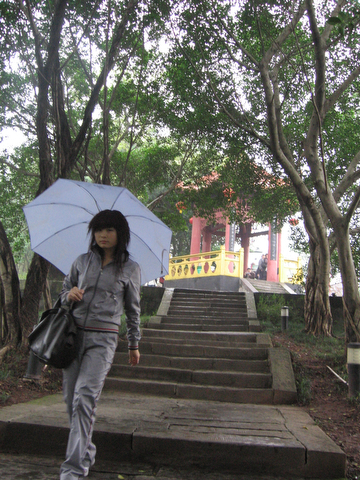
A light rain was falling as we climbed the mountain.
A graceful doorway in a part of the complex that was rebuilt in the 1980s after having been destroyed by Red Guards during the Cultural Revolution.
At one point, our guide (call him Pat) cautioned us not to rub up against the yellow walls because the paint might stain our clothing. It turned out that, although the original Ghost City had been built centuries ago, these buildings dated from sometime in the 1980s. With the exception of the last and highest of the structures, all of the Fengdu complex had been destroyed during the Cultural Revolution (like, before the chairlift was built to haul tourists up the mountain) and then rebuilt—just for us—using poured concrete and other shoddy materials, including cheap paint, so that in just 20 years it became instantly ancient. Fake and real balanced perfectly, like yin and yang.
A Buddha in one of the Fengdu shrines.
One of the new gates. Most of the new buildings and sculptures are made of concrete. Still, they have achieved a sort of traditional beauty—and an almost instant appearance of age.
Near the authentic temple at the top of the hill, the walls were painted a brilliant blue that, our guide explained, Chinese people find terrifying. Being from a culture that thinks the color blue is pacific and comforting, I was curious to notice how, as the blue walls neared the ground, their paint was peeling and mossy from the dampness. Here, at the margin of our two cultures, I found the day’s best images—little close-ups of green, white, and blue that seemed like landscape paintings. People stared at me as I got down on my knees with the camera to capture them with my macro lens, composing carefully as I saw mountains, sky, trees, and lush green fields. If we are here celebrating the underworld, I thought, then there’s nothing to be afraid of.
While everyone else was looking through the windows at the right at a chamber of horrors, I got interested in the blue-washed wall on the left. Below is one of the close-up landscapes I found there—a combination of peeling blue paint and mossy algae. Pretty, huh?
At the top of the mountain, we reached a pagoda-like tower and, nearby, the only truly ancient building of the day. Clearly, there was something to this erasure-of-memory business, because somewhere along the way, I had forgotten my hat. I informed Shao Yan, who shook her head, laughing at my childlike ways.
The last pavilion, which was guarded by some fearsome figures, housed a golden statue representing the King of the Underworld—plus a bizarre roomful doll-like wood figures depicting horrific torture scenes, like something out of Dante or Breughel. Haili declared the whole thing to be “pretty scary,” but by now my spiritual receptors had been overwhelmed. I couldn’t wait to get to the bottom of the hill again—back to the rough brown reality of the river.
Guardians at the Temple of Hell.
The King of Hell.
Instead of taking the steps (or the chair lift) all the way down to the vendor street and the bus park, a few of us found the service road a little off to the right. Across a narrow valley to the west, perched high on another hill, was a four- or five-storey building with a white plaster facade meant to look like the face of some sort of ancient god. Its eyes were hollow windows and there were other signs that it was actually an abandoned building, not the ninth wonder of the world. I learned later from Raynor Shaw’s book that it was a hotel and restaurant that had never opened. Too bad, really; it would have added immeasurably to the kitch of Fengdu.
The Victoria Queen drove west for the remainder of the day. The spectacle of the Three Gorges was behind us and we began to notice a strengthened current in the Yangzi. Hundreds of kilometers above the big dam, the reservoir ended and the river came alive, buffeting the ship as it zig-zagged from one bank to the other, following the navigation channel. For the first time, we could feel the water beneath the keel and hear the straining propellers as the ship pushed against the thick brown moving mass of the Yangzi. This slowed our upstream progress significantly, but the downstream traffic was fairly flying.
In the early afternoon, the river guides announced that we had entered the municipality of Chongqing—a vast political subdivision. An estimated 32 million people live within this municipal boundary, allowing Chongqing to claim that it is the largest city in the world. (Later, a guide in Shanghai would make a similar claim, but for a much more compact land area.) Activity along the riverbanks was becoming increasingly industrial and the already hazy afternoon air began to fill with smoke and smog until visibility dropped to a few dozen meters.
This giant cement factory was barely visible in the haze from about 200 meters offshore. I took this picture using the sepia-tone feature of my camera, which accentuates the contrast. There wasn’t much point in photographing this in color.
Shortly after dinner, we went on deck to see the lights of central Chongqing as we approached our dock there. It was lit up like Las Vegas—with almost every skyscraper (there were scores) illuminated with some sort of pattern, many of them flashing and moving. Along the south bank of the Yangzi, neon animations danced along the shore and music blared across the water.
Lights of Chongqing. At 10:00 p.m., after we were docked nearby, loudspeakers blared the Chinese national anthem as neon lights displayed the musical score and the words across the river. This was repeated at 10:30, and then the entire lighting display was turned off for the night.
As I stood watching all of this in the bow, the crew executed a tricky docking maneuver in the swift current. We approached our starboard-side dock with considerable headway against the current—forward motion that was clearly needed in order to maintain steerage with the ship’s rudder. (Rudders are useless if a boat is standing still, and any current quickly takes over and turns a vessel to its own will.)
I was surprised when we passed our dock at a speed of three or four knots—and even more surprised when, with a huge clatter, the ship’s anchor was loosed from the deck just below where I was standing. As the anchor bit into the river bottom, the Victoria Queen came to a halt about 75 meters upriver from the dock. Then, the rudder was put over to port and the stern of the ship began a slow drift to starboard in the strong current, swinging on the anchor chain. A meter or two at a time, the great chain was payed out, allowing the ship to back up and swing further toward the dock. Before long, messenger lines were thrown ashore and thick steel cables were pulled across, first at the stern and then at the bow. The cables were made fast to winches, and, while the anchor chain was kept taut against the power of the river, we were drawn into the dock.
We spent the night aboard the ship and went ashore in the morning—after yet another buffet breakfast. A uniformed brass band played as we went down the gangway. Their tune, “Marching Through Georgia,” and the straining porters who carried our luggage at the end of stout bamboo poles up the steep steps to the buses, evoked another era.
While the band played “Marching Through Georgia” …
… porters known as bang bang jun (pole- or stick-army) still ply their trade along the waterfront, hauling heavy loads from the dock to the top of the riverbank.
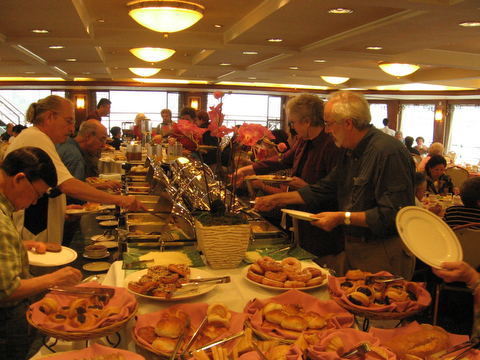
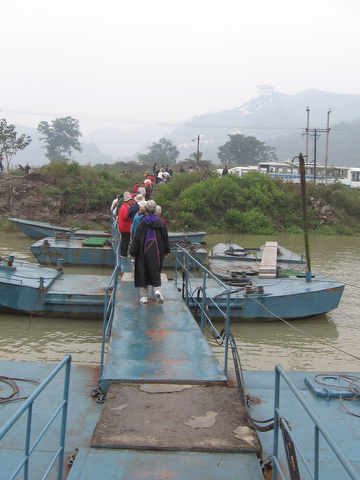
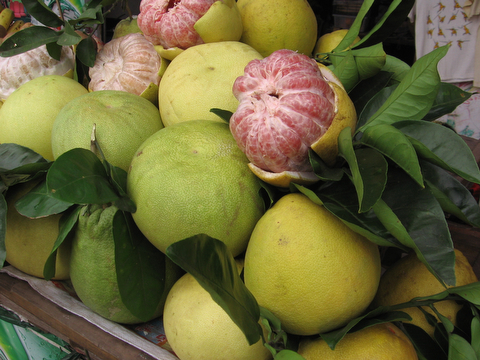
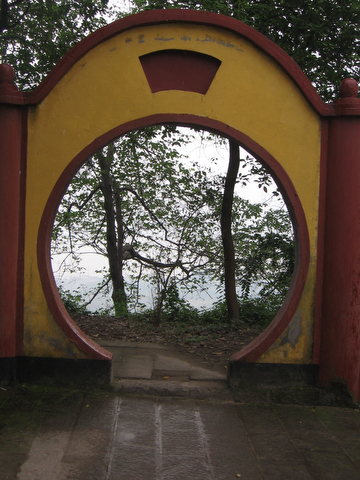
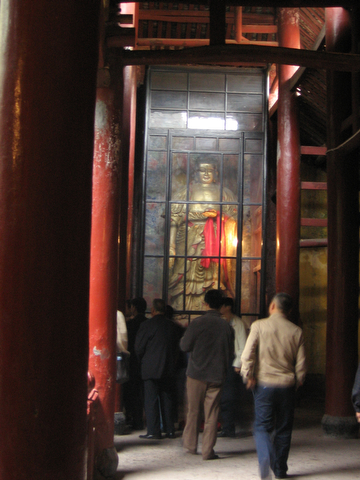
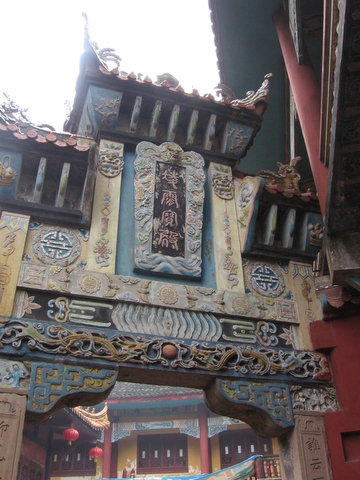
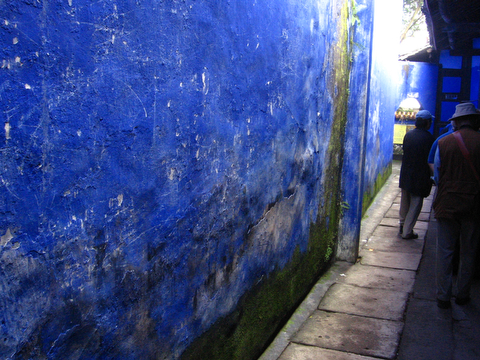
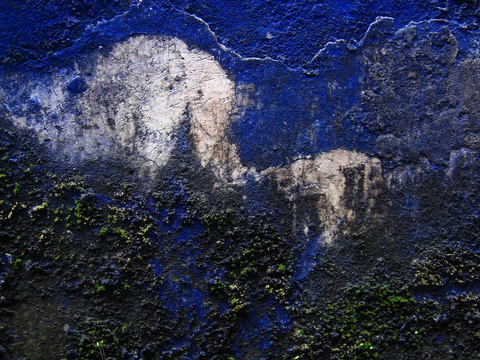
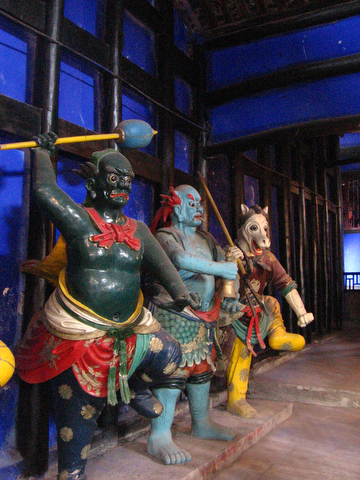
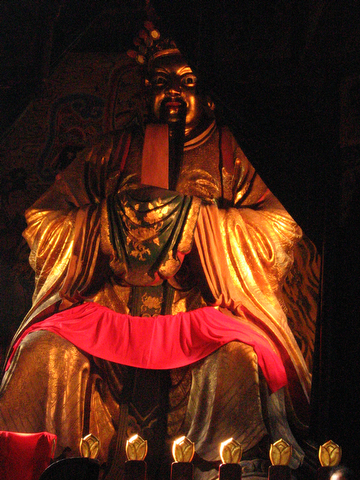
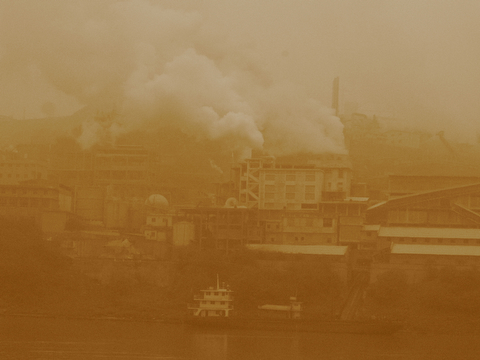

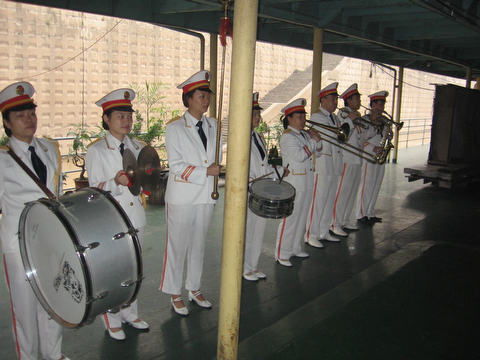
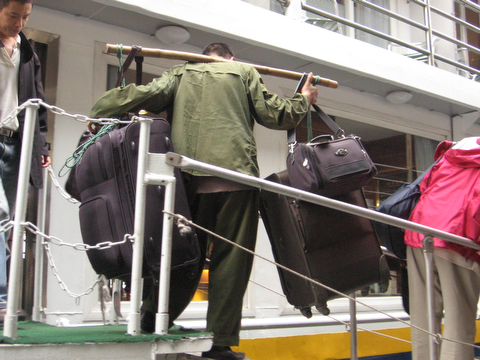
What a great site. Went there 2006 and loved all aspects of the country except the political views, pollution and the oppression that is still in the faces of the people.
4500+ years of history shows itself in so many ways. It is absolutely a place that leaves me in awe.
Thanks so much